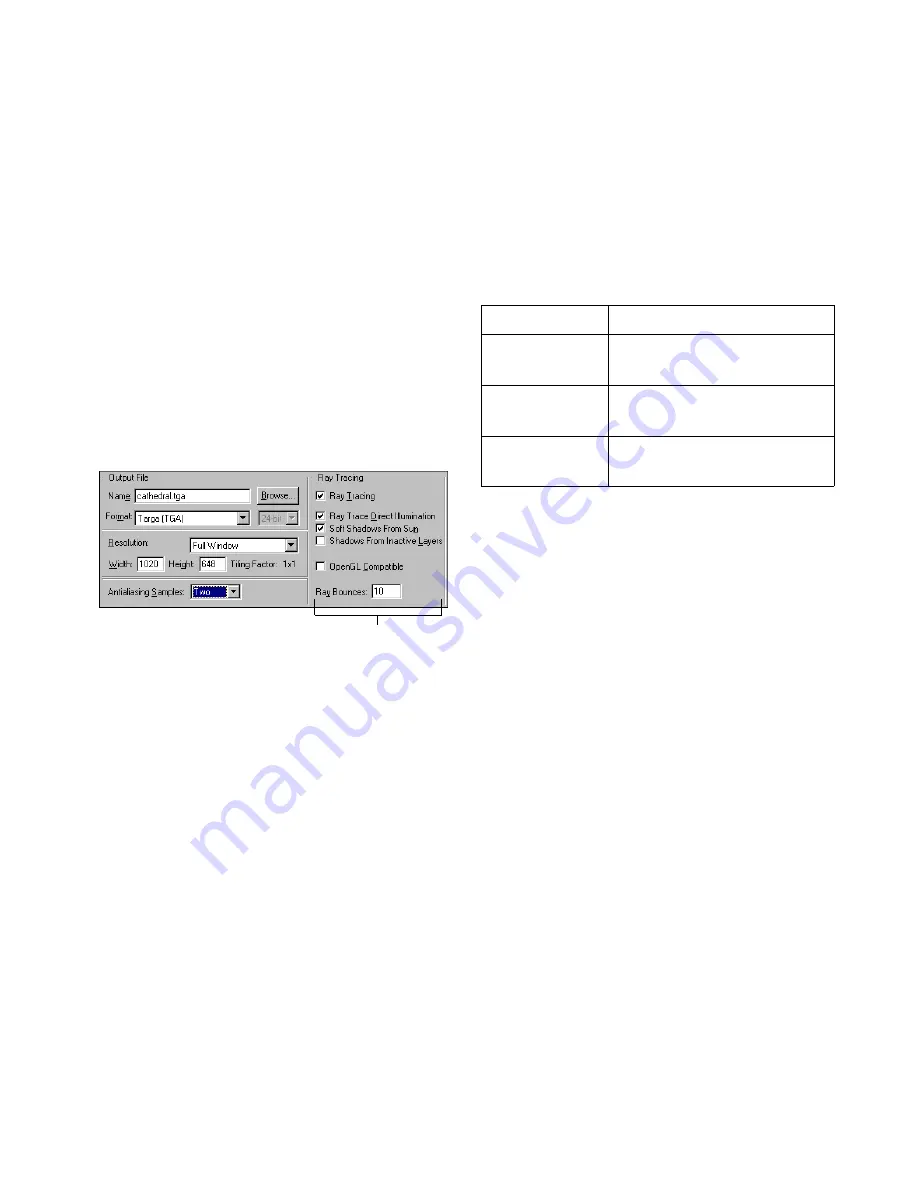
Rendering Multiple Views
217
❚❘❘
5.
To increase the number of antialiasing samples,
select the appropriate level from the Antialiasing
Samples list.
Note:
Increasing the antialiasing level can signifi-
cantly increase your processing time. For more
information, see “Antialiasing” on page 214.
6.
Enable Ray Tracing.
The following options become available:
•
Ray Trace Direct Illumination
•
Shadows from Inactive Layers
•
OpenGL Compatible.
7.
To ray trace the direct lighting contribution from
the sun and luminaires marked for ray tracing, en-
able Ray Trace Direct Illumination.
If you enable this option, the Soft Shadows From Sun
option becomes available.
Note:
Lightscape ray traces only the luminaires
that have their Ray Trace Direct Illumination prop-
erty enabled.
8.
To blur the edges of shadow boundaries caused
by the sun, enable Soft Shadows From Sun.
9.
To generate images that closely match the
OpenGL display, enable OpenGL Compatible.
10.
Enter the number of ray bounces in the Ray
Bounces box.
Rendering Multiple Views
Lightscape has three options for controlling the view
and the number of images it creates: Current View,
List of Views, and Animation File.
These options are available when rendering with
either OpenGL or ray tracing.
Rendering a List of Views
You can create image files of multiple views by
selecting the List of Views option. To create each
image filename, Lightscape combines the output
filename, specified in the Output File Name box,
with the prefix of the view name and the extension of
the specified image output type.
For example, if you select .bmp output, enter
set1
in the Output File Name box, and load three view
files (
v1.vw
,
v2.vw
, and
v3.vw
). Lightscape
names the resulting images
set1v1.bmp
,
set1v2.bmp
, and
set1v3.bmp
. The .vw file
extension is dropped in the resulting filenames.
Note:
If you need to maintain the DOS 8.3 naming
conventions, make sure that the image name,
combined with the longest view file prefix, does
not exceed eight characters.
To render a list of views:
1.
In the Rendering dialog, set the required render-
ing options. For more information, see “Rendering
Ray Tracing options
Select:
To:
Current View
Create a single image using the
current view.
List of Views
Create an image for each view in
the View list.
Animation File
Create an image for each frame
in an animation file.
Summary of Contents for LIGHTSCAPE
Page 1: ...SULO 4 31 93 36034333308355 LJKWVFDSH...
Page 18: ...NOTES 10...
Page 110: ...NOTES 102...
Page 136: ...NOTES 128...
Page 166: ...NOTES 158...
Page 176: ...NOTES 168...
Page 202: ...NOTES 194...
Page 210: ...NOTES 202...
Page 248: ...NOTES 240...
Page 294: ...NOTES 286...
Page 308: ...NOTES 300...
Page 316: ...NOTES 308...
Page 324: ...NOTES 316...
Page 342: ...Glossary 334 Lightscape...
Page 360: ...Index ix 352 Lightscape...
Page 362: ......






























